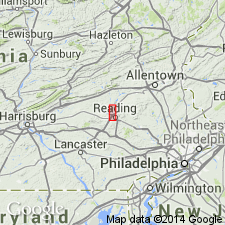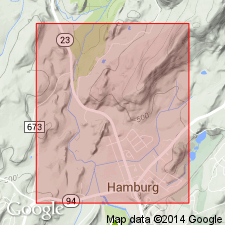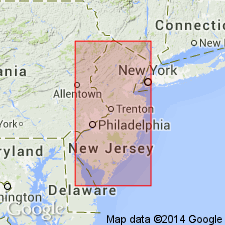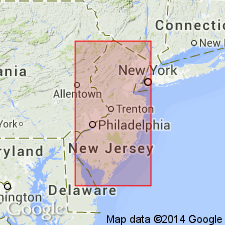
- Usage in publication:
-
- Epler formation
- Modifications:
-
- Named
- Dominant lithology:
-
- Dolomite
- Limestone
- AAPG geologic province:
-
- Appalachian basin
Summary:
Name Epler formation proposed in southeastern PA for interbedded limestone and dolomite overlying Rickenbach formation (new) and underlying dolomite beds here termed Ontelaunee formation. Divided into two unnamed members: upper characterized by large proportion of calcarenite with bioclastics and limestone pebbles, and lower in which calcilutite is common. Both members contain interbedded dolomite with much larger percentage in lower member. Thickness 800 ft in type section. Contact with underlying Rickenbach is transitional, and boundary set at base of first limestone above solid dolomite body of the Rickenbach. Contact with overlying Ontelaunee is placed at top of first limestone bed beneath lowest chert bed of Ontelaunee, and in Berks Co. this contact is 100 ft below lower chert bed. Contact zone is gradational. Age is Early Ordovician.
Source: GNU records (USGS DDS-6; Reston GNULEX).

- Usage in publication:
-
- Epler Formation*
- Modifications:
-
- Overview
- Areal extent
- AAPG geologic province:
-
- Appalachian basin
Summary:
Epler Formation of Beekmantown Group adopted for map area in PA and NJ. Age is Early Ordovician.
Source: GNU records (USGS DDS-6; Reston GNULEX).

- Usage in publication:
-
- Epler Formation
- Modifications:
-
- Revised
- AAPG geologic province:
-
- Appalachian basin
Summary:
Epler Formation subdivided into ascending Branchville, Big Springs and Lafayette Members in northwestern NJ. Branchville is predominantly dolomite with chert and shale interbeds and ranges in thickness from 45 to 94 m. Big Springs is dolomite and limestone with bands of siliceous shale and quartzite. Thickness ranges from 12 to 46 m. Lafayette is dolomite with shale and chert beds and ranges in thickness from 15 to 76 m.
Source: GNU records (USGS DDS-6; Reston GNULEX).

- Usage in publication:
-
- Epler Formation
- Modifications:
-
- Overview
- AAPG geologic province:
-
- Appalachian basin
Summary:
From Hope to Hamburg, NJ, the Epler is mainly dolomite, with occasional limestone lenses in the middle of the formation. The New Jersey Geological Survey places the Rickenbach-Epler contact at a massive chert zone instead of at the lowest limestone bed above which the lithic features differ from those of the underlying rock as did Hobson (1957) and Drake (1969). Nomenclature in this report follows Markewicz and Dalton (1977) who divided the unit into the basal Branchville Member, the Big Springs Member, and the Lafayette Member. Underlies Ontelaunee Formation or unconformably underlies Knox Group.
Source: GNU records (USGS DDS-6; Reston GNULEX).

- Usage in publication:
-
- Epler Formation*
- Modifications:
-
- Age modified
- Biostratigraphic dating
- AAPG geologic province:
-
- Appalachian basin
Summary:
Age of Epler Formation of Beekmantown Group refined to middle and late Ibexian. A few isolated samples of conodont DIAPHORODUS DELICATUS indicate Epler extends at least into upper Ibexian OEPIKODUS COMMUNIS Zone.
Source: GNU records (USGS DDS-6; Reston GNULEX).
For more information, please contact Nancy Stamm, Geologic Names Committee Secretary.
Asterisk (*) indicates published by U.S. Geological Survey authors.
"No current usage" (†) implies that a name has been abandoned or has fallen into disuse. Former usage and, if known, replacement name given in parentheses ( ).
Slash (/) indicates name conflicts with nomenclatural guidelines (CSN, 1933; ACSN, 1961, 1970; NACSN, 1983, 2005, 2021). May be explained within brackets ([ ]).

